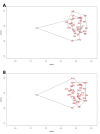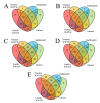Wastewater treatment works change the intestinal microbiomes of insectivorous bats
- PMID: 33657147
- PMCID: PMC7928523
- DOI: 10.1371/journal.pone.0247475
Wastewater treatment works change the intestinal microbiomes of insectivorous bats
Abstract
Mammals, born with a near-sterile intestinal tract, are inoculated with their mothers' microbiome during birth. Thereafter, extrinsic and intrinsic factors shape their intestinal microbe assemblage. Wastewater treatment works (WWTW), sites synonymous with pollutants and pathogens, receive influent from domestic, agricultural and industrial sources. The high nutrient content of wastewater supports abundant populations of chironomid midges (Diptera), which transfer these toxicants and potential pathogens to their predators, such as the banana bat Neoromicia nana (Vespertilionidae), thereby influencing their intestinal microbial assemblages. We used next generation sequencing and 16S rRNA gene profiling to identify and compare intestinal bacteria of N. nana at two reference sites and two WWTW sites. We describe the shared intestinal microbiome of the insectivorous bat, N. nana, consisting of seven phyla and eleven classes. Further, multivariate analyses revealed that location was the most significant driver (sex, body size and condition were not significant) of intestinal microbiome diversity. Bats at WWTW sites exhibited greater intestinal microbiota diversity than those at reference sites, likely due to wastewater exposure, stress and/or altered diet. Changes in their intestinal microbiota assemblages may allow these bats to cope with concomitant stressors.
Conflict of interest statement
The authors have declared that no competing interests exist.
Figures




Similar articles
-
Haematological and genotoxic responses in an urban adapter, the banana bat, foraging at wastewater treatment works.Ecotoxicol Environ Saf. 2015 Apr;114:304-11. doi: 10.1016/j.ecoenv.2014.04.043. Epub 2014 Jun 20. Ecotoxicol Environ Saf. 2015. PMID: 24953517
-
The brains of bats foraging at wastewater treatment works accumulate arsenic, and have low non-enzymatic antioxidant capacities.Neurotoxicology. 2018 Dec;69:232-241. doi: 10.1016/j.neuro.2017.12.004. Epub 2017 Dec 14. Neurotoxicology. 2018. PMID: 29248512
-
The role of host traits and geography in shaping the gut microbiome of insectivorous bats.mSphere. 2024 Apr 23;9(4):e0008724. doi: 10.1128/msphere.00087-24. Epub 2024 Mar 21. mSphere. 2024. PMID: 38509042 Free PMC article.
-
Foraging at wastewater treatment works affects brown adipose tissue fatty acid profiles in banana bats.Biol Open. 2016 Jan 6;5(2):92-9. doi: 10.1242/bio.013524. Biol Open. 2016. PMID: 26740572 Free PMC article.
-
Designer microbiomes for environmental, energy and health biotechnology.Curr Opin Microbiol. 2018 Jun;43:117-123. doi: 10.1016/j.mib.2017.12.007. Epub 2018 Feb 3. Curr Opin Microbiol. 2018. PMID: 29366937 Review.
Cited by
-
Gut microbiome community profiling of Bornean bats with different feeding guilds.Anim Microbiome. 2025 Mar 5;7(1):21. doi: 10.1186/s42523-025-00389-w. Anim Microbiome. 2025. PMID: 40045431 Free PMC article.
-
Effects of anthropogenic stress on hosts and their microbiomes: Treated wastewater alters performance and gut microbiome of a key detritivore (Asellus aquaticus).Evol Appl. 2023 Mar 30;16(4):824-848. doi: 10.1111/eva.13540. eCollection 2023 Apr. Evol Appl. 2023. PMID: 37124094 Free PMC article.
-
Shift in diet composition of a riparian predator along a stream pollution gradient.Proc Biol Sci. 2024 Nov;291(2035):20242104. doi: 10.1098/rspb.2024.2104. Epub 2024 Nov 20. Proc Biol Sci. 2024. PMID: 39561799 Free PMC article.
-
Impacts of environmentally relevant concentrations of antibiotic cocktails on the skin microbiome of Eurasian carp (Cyprinus carpio).Anim Microbiome. 2025 Jul 8;7(1):73. doi: 10.1186/s42523-025-00434-8. Anim Microbiome. 2025. PMID: 40629427 Free PMC article.
-
Characterization of the bacterial microbiome of non-hematophagous bats and associated ectoparasites from Brazil.Front Microbiol. 2023 Oct 19;14:1261156. doi: 10.3389/fmicb.2023.1261156. eCollection 2023. Front Microbiol. 2023. PMID: 37928691 Free PMC article.
References
Publication types
MeSH terms
Substances
LinkOut - more resources
Full Text Sources
Other Literature Sources

